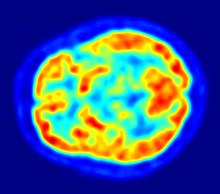Scintigraphy
| Scintigraphy | |
|---|---|
 Scintigraphy | |
| ICD-9-CM | 92.0-92.1 |
| MeSH | D011877 |
| OPS-301 code | 3-70 |
Scintigraphy(from Latinscintilla,"spark" ), also known as agamma scan,is a diagnostic test innuclear medicine,whereradioisotopesattached to drugs that travel to a specific organ or tissue (radiopharmaceuticals) are taken internally and the emittedgamma radiationis captured bygamma cameras,which are external detectors that form two-dimensional images[1]in a process similar to the capture ofx-ray images.In contrast,SPECTandpositron emission tomography(PET) form 3-dimensional images and are therefore classified as separate techniques from scintigraphy, although they also usegamma camerasto detect internal radiation. Scintigraphy is unlike a diagnostic X-ray where external radiation is passed through the body to form an image.
Process[edit]

Scintillographyis animagingmethod ofnuclear eventsprovoked bycollisionsorcharged current interactionsamong nuclear particles orionizing radiationandatomswhich result in a brief, localised pulse ofelectromagnetic radiation,usually in thevisible lightrange (Cherenkov radiation). This pulse (scintillation) is usually detected and amplified by aphotomultiplierorcharged coupled deviceelements, and its resulting electrical waveform is processed bycomputersto provide two- and three-dimensional images of a subject orregion of interest.


Scintillography is mainly used inscintillation camerasinexperimental physics.For example, hugeneutrino detectionunderground tanks filled withtetrachloroethyleneare surrounded by arrays of photo detectors in order to capture the extremely rare event of a collision between the fluid's atoms and aneutrino.
Another extensive use of scintillography is inmedical imagingtechniques which usegamma raydetectors calledgamma cameras.Detectors coated with materials which scintillate when subjected to gamma rays are scanned with optical photon detectors andscintillation counters.The subjects are injected with specialradionuclideswhich irradiate in the gamma range inside the region of interest, such as theheartor thebrain.A special type of gamma camera is theSPECT(Single Photon Emission Computed Tomography). Another medical scintillography technique, thePositron-emission tomography(PET), which uses the scintillations provoked byelectron-positron annihilationphenomena.
By organ or organ system[edit]
Biliary system (cholescintigraphy)[edit]
Scintigraphy of thebiliary systemis calledcholescintigraphyand is done to diagnose obstruction of thebile ductsby a gallstone (cholelithiasis), a tumor, or another cause.[2]It can also diagnosegallbladder diseases,e.g. bile leaks ofbiliary fistulas.[2]In cholescintigraphy, the injected radioactive chemical is taken up by the liver and secreted into the bile. The radiopharmaceutical then goes into the bile ducts, the gallbladder, and the intestines. The gamma camera is placed on the abdomen to picture these perfused organs.[2]Other scintigraphic tests are done similarly.[2]
Lung scintigraphy[edit]

The most common indication for lung scintigraphy is to diagnosepulmonary embolism,e.g. with aventilation/perfusion scanand may be appropriate for excluding PE in pregnancy.[3]Less common indications include evaluation oflung transplantation,preoperative evaluation, evaluation ofright-to-left shunts.[4]
In the ventilation phase of a ventilation/perfusion scan, a gaseous radionuclidexenonortechnetiumDTPAin an aerosol form (or ideally using Technegas, a radioaerosol invented in Australia by Dr Bill Burch and Dr Richard Fawdry) is inhaled by the patient through a mouthpiece or mask that covers the nose and mouth. The perfusion phase of the test involves the intravenous injection of radioactive technetiummacro aggregated albumin(Tc99m-MAA). A gamma camera acquires the images for both phases of the study.
Bone[edit]
For example, the ligandmethylene-diphosphonate(MDP) can be preferentially taken up by bone. By chemically attachingtechnetium-99mto MDP, radioactivity can be transported and attached to bone via thehydroxyapatitefor imaging. Any increased physiological function, such as a fracture in the bone, will usually mean increased concentration of the tracer.
Heart[edit]
Athallium stress testis a form of scintigraphy, where the amount ofthallium-201 detected in cardiac tissues correlates with tissue blood supply. Viable cardiac cells have normalNa+/K+ion exchange pumps.Thallium binds the K+pumps and is transported into the cells. Exercise ordipyridamoleinduces widening (vasodilation) of normal coronary arteries. This produces coronary steal from areas of ischemia where arteries are already maximally dilated. Areas of infarct orischemic tissuewill remain "cold". Pre- and post-stress thallium may indicate areas that will benefit from myocardialrevascularization.Redistribution indicates the existence ofcoronary stealand the presence of ischemiccoronary artery disease.[5]
Parathyroid[edit]
Tc99m-sestamibiis used to detectparathyroid adenomas.[6]
Thyroid[edit]
To detect metastases/function of thyroid, the isotopestechnetium-99moriodine-123are generally used,[7][8]and for this purpose the iodide isotope does not need to be attached to another protein or molecule, because thyroid tissue takes up free iodide actively.
Renal and urinary systems[edit]
Full body[edit]
Examples aregallium scans,indium white blood cell scans,iobenguanescan (MIBG) andoctreotide scans.The MIBG scan detects adrenergic tissue and thus can be used to identify the location oftumors[9]such aspheochromocytomasandneuroblastomas.
Function tests[edit]
Certain tests, such as theSchilling testandurea breath test,use radioisotopes but are not used to produce a specific image.
History[edit]
Scintigraphic scanning was invented and proven by Neurologist and Radiologist professor Bernard George Ziedses des Plantes.[10]He presented the results in 1950 under the name 'indirectAutoradiograph’. In 1970, the Physikalisch-Medizinische Gesellschaft für Neuroradiologie (The Physics and Medical Society for Neuroradiology) instituted the ‘Ziedses des Plantes Medal'. It was first awarded to W. Oldendorf en G. Hounsfield in 1974 forComputer Tomography (CT).Later, in 1985, the medal was awarded to Ziedses des Plantes himself. In 1977 he received The Roentgen Medal.[11]
See also[edit]
References[edit]
- ^"Scintigraphy".Dorland's Medical Dictionary for Health Consumers; Saunders; Saunders Comprehensive Veterinary Dictionary(3rd ed.). McGraw-Hill Concise Dictionary of Modern Medicine. 2007.
- ^abcd"Definition of Scintigraphy".MedicineNet.6 December 2003.
- ^van Mens TE, Scheres LJ, de Jong PG, Leeflang MM, Nijkeuter M, Middeldorp S (January 2017). Cochrane Vascular Group (ed.)."Imaging for the exclusion of pulmonary embolism in pregnancy".The Cochrane Database of Systematic Reviews.1(1): CD011053.doi:10.1002/14651858.CD011053.pub2.PMC6464730.PMID28124411.
- ^"Guideline for Lung Scintigraphy"(PDF)(3.0 ed.). Society of Nuclear Medicine Procedure. 7 February 2004. Archived fromthe original(PDF)on 23 July 2011.Retrieved2 April2010.
- ^Taylor GJ (2004).Primary Care Cardiology.Wiley-Blackwell. p. 100.ISBN1-4051-0386-8.
- ^Rosen CJ (2008-11-18).Primer on the Metabolic Bone Diseases and Disorders of Mineral Metabolism.John Wiley and Sons. pp. 168–.ISBN978-0-9778882-1-4.Retrieved17 July2011.
- ^Hindié E, Zanotti-Fregonara P, Keller I, Duron F, Devaux JY, Calzada-Nocaudie M, et al. (September 2007)."Bone metastases of differentiated thyroid cancer: impact of early 131I-based detection on outcome".Endocrine-Related Cancer.14(3).Bioscientifica:799–807.doi:10.1677/ERC-07-0120.PMID17914109.
- ^Mandel SJ, Shankar LK, Benard F, Yamamoto A, Alavi A (January 2001)."Superiority of iodine-123 compared with iodine-131 scanning for thyroid remnants in patients with differentiated thyroid cancer".Clinical Nuclear Medicine.26(1): 6–9.doi:10.1097/00003072-200101000-00002.PMID11139058.S2CID44740573.
- ^Scarsbrook AF, Ganeshan A, Statham J, Thakker RV, Weaver A, Talbot D, et al. (2007). "Anatomic and functional imaging of metastatic carcinoid tumors".Radiographics.27(2): 455–77.doi:10.1148/rg.272065058.PMID17374863.
- ^Valk, Jaap (June 1994)."Bernard George Ziedses des Plantes, MD".Radiology.191(3): 876.doi:10.1148/radiology.191.3.876-b.
- ^Busch, Dr. Uwe (1977)."The Roentgen Medal 1970-1979".Deutsches Röntgen Museum.RetrievedAugust 7,2022.
